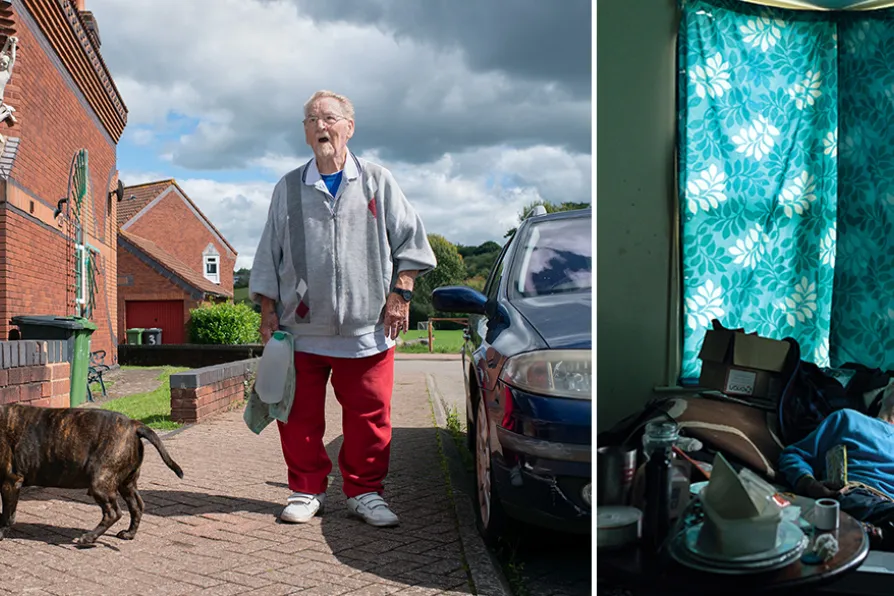JOHN GREEN is fascinated by a very readable account of Britain’s involvement in South America

 (L) A resident of Burnthouse Lane estate; (R) Derek, a homeless hostel resident who lives in Teesside
[(L) Michelle Sank; (R) Mark Chapman]
(L) A resident of Burnthouse Lane estate; (R) Derek, a homeless hostel resident who lives in Teesside
[(L) Michelle Sank; (R) Mark Chapman] God’s promises mean everything
Mark Chapman, Dewi Lewis, £35
Burnthouse Lane
Michelle Sank, Dewi Lewis, £35
LAST year, Dewi Lewis Publishing celebrated 30 years as an independent publisher.
It is renowned as a publisher of high-quality photographic volumes, beautifully designed and printed.
Its publications have gained an international reputation and include books by leading British and international photographers. The ambition of the company is to bring to the attention of a wider public accessible but challenging contemporary photography by established and lesser known practitioners. These two new volumes continue that tradition.
[[{"fid":"68056","view_mode":"inlineleft","fields":{"format":"inlineleft","field_file_image_alt_text[und][0][value]":false,"field_file_image_title_text[und][0][value]":false},"link_text":null,"type":"media","field_deltas":{"1":{"format":"inlineleft","field_file_image_alt_text[und][0][value]":false,"field_file_image_title_text[und][0][value]":false}},"attributes":{"class":"media-element file-inlineleft","data-delta":"1"}}]]Mark Chapman is a photographer and filmmaker from north-east England. This is his first photo-book, and God’s Promises Mean Everything spans seven years in the life of Derek, a homeless hostel resident who lives in Teesside, an area that has a rich industrial history.
After being granted permission by the hostel, he visited Derek 1-2 times a month, to drop off food or just hang out, talk and listen to music. Through these visits, this time spent in each other’s company became essential to the work and allowed a unique fully collaborative project to develop.
The photo-book is an immersive long-term character portrait that extends over a number of years, but limits its perspective to a single room. Haunted by the spectre of the family he lost, Derek lives without the safety nets many of us take for granted. Significant life choices – involving financial difficulties, mental and physical health – are always close to the surface.
As individual images, Chapman’s photographs are not notable but taken as a whole and as a narrative, they are a powerful condemnation of a society that allows individuals like Derek, hit by misfortune to tumble into the pit of extreme poverty, mental illness and often drug dependency. There is a photo of crumpled bedding, a half-finished meal of tinned noodles, Derek lying on the bed or slouched despondently in a ripped chair, his bared skeletal torso, like an altar painted by Grunewald of Christ, or a rare image of his face – that of a man doomed.
It reveals the unsettling fragility in the connections that make up our everyday experience. It is a personal, empathetic portrait of a man trapped in difficult circumstances. A story of disconnection and loss, but also of survival and daily rebellion.
Michelle Sank has developed an international reputation for her powerful environmental portraits and landscapes. Born in South Africa and growing up under apartheid, she settled in Britain in 1987. She cites this background as informing her interest in sub-cultures and the exploration of contemporary social issues and challenges.
Her crafted portraits and landscapes meld place and person creating sociological, visual and psychological narratives.
[[{"fid":"68057","view_mode":"inlineright","fields":{"format":"inlineright","field_file_image_alt_text[und][0][value]":false,"field_file_image_title_text[und][0][value]":false},"link_text":null,"type":"media","field_deltas":{"2":{"format":"inlineright","field_file_image_alt_text[und][0][value]":false,"field_file_image_title_text[und][0][value]":false}},"attributes":{"class":"media-element file-inlineright","data-delta":"2"}}]]Almost all her images are straightforward portraits of the residents of Burnthouse Lane estate.
The estate was designed and built by Exeter Council in the idealistic 1920s to rehouse impoverished people from the West Quarter slums. Designed along Garden City lines and purposely self-contained, it was a place for working-class families to live. In the 1980s, Margaret Thatcher’s Right to Buy scheme meant that some properties became privately owned, but Burnthouse Lane is still referred to as a council estate.
The deprivation it was supposed to overcome has continued to haunt it, but its isolated nature and the intricate labyrinth of lanes have helped establish a close-knit community and a sense of solidarity among the residents. It is a rather incongruous place, situated on the outskirts of the city, surrounded by rolling meadows, trees and hedges, in what today would be the ideal site for an affluent suburb, not a council estate for the poor and disadvantaged. But this estate was built when the idea of public housing and social improvement was very much the ethos of many a local authority.
The subjects of Sank’s photographs are clearly aware of being photographed and are relaxed in the presence of a photographer they know. There is a wonderful mix of young black girls, unemployed African men, teenage white girls and older residents. She only photographs outside, in residents’ gardens, on the street, in front of their houses or relaxing in the surrounding meadows. She builds up a colourful portfolio of a lively, multicultural community, seemingly at peace with itself.
The renowned photographer David Goldblatt has said of her portraiture that there is “an unstrained yet visually sophisticated synthesis of subject and context... people are not typecast or stereotyped; they are just ‘ordinary’. They seem completely themselves, Sank has allowed each of them simply to be... something has been evoked that seems to come from deep within... it is the unique spirit of the other person.”














